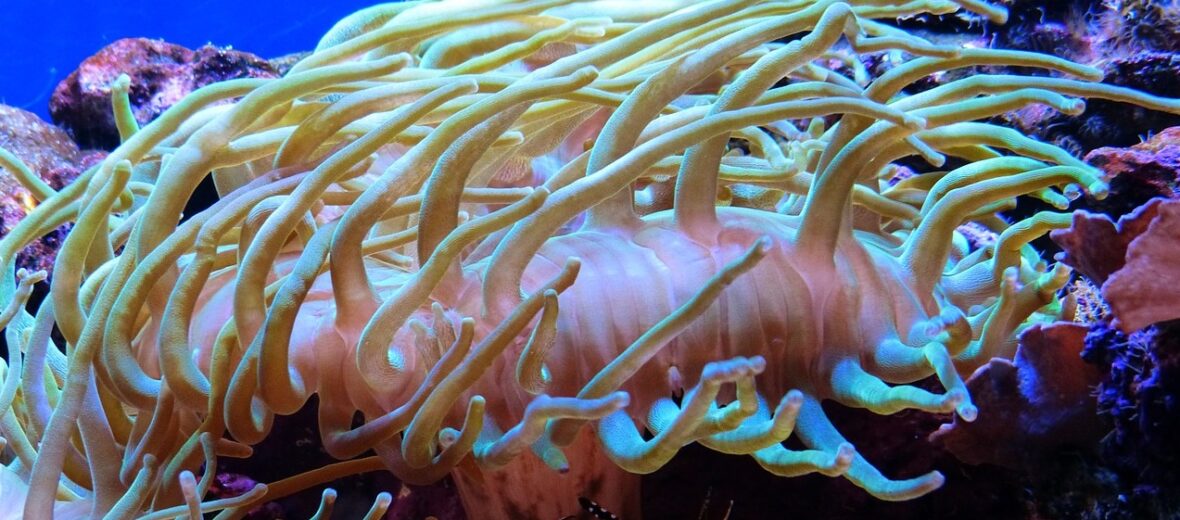
The sea anemone is a predatory invertebrate that inhabits every ocean around the world. They can be found at depths of up to and over 33,000 feet deep! These fascinating creatures look fragile but they are surprisingly hardy. Most tend to be quite stationary but they can and do move. Some even have the ability to swim by wriggling their pedal disk (foot) back and forth clumsily and drifting from one spot to another. The anemone is carnivorous (eats meat). Most live in salt water, but there are some species that survive in brackish water (partially salty water with a lower specific gravity).
First the Stats…
Scientific name: Actiniaria
Weight: Up to 440 lbs.
Length: Up to 5 feet in diameter
Lifespan: Up to 50 years
Now on to the Facts!
1.) Anemones both eat and defecate through their mouth. Talk about halitosis.
2.) The giant green anemone is the largest known anemone in the world, measuring around 3 feet across!
3.) Most anemones consist of a single polyp with a columnar trunk topped with an oral disc and a ring of tentacles, plus a central mouth.
4.) Once touched the tentacles will use their cnidocytes to shoot stinging nematocysts into their prey that inject venom. This venom paralyzes the prey and then the tentacles guide the unfortunate prey into their mouth.
5.) Some of these creatures have little noticeable venom. Others have quite powerful envenomation capabilities. I have personally been stung many times by a fire anemone. I had a burning rash over 40% of my arm that lasted for a month!
But wait, there’s more on the sea anemone!
6.) There are around 1,000 known species of anemones around the world.
7.) They prey on mussels, zooplankton, fish, small crustaceans, shrimp, tiny marine larvae, worms, and any other meaty goodness that happens their way.
Did you know…?
Some hermit crabs will attach anemones to their shells for camouflage and protection.
8.) Anemones get much of their food from ensnaring it. But they can also live off of symbiotic unicellular (single cell) algae that grows in their cells.
9.) These amazing creatures have a relationship with anemone fish. This is called mutualism. The fish clean the anemone and keep it safe from predatory fish and the anemone keeps the fish safe from its predators and provides a home at the same time.
10.) Sea anemones are able to reproduce either sexually, releasing sperm and eggs into the water or asexually which is also known as a process called lateral fission. This involves sprouting an identical copy of themselves by splitting off at the side.
But wait, there’s even more on the sea anemone!
11.) Seeing as clownfish have a mutualistic relationship with anemones, many aquarium enthusiasts will have this interesting pair in their salt water aquarium.
12.) Being cnidarians, sea anemones are closely related to jellyfish and corals.
13.) Phyllodiscus semoni, Actinodendron arboreum, and Stichodactyla spp. have been known to cause serious injuries to humans.
14.) They are preyed on by by certain sea stars, sea slugs, flounders, eels, and codfish.
15.) The anemone, at least the ones in shallow waters, have a symbiotic relationship with algae. For providing the algae a safe place from critters who would eat it and giving more exposure to sunlight, the anemone in turn gets oxygen and sugar, the bi-products of photosynthesis from the algae.
Now a Short Sea Anemone Video!
Also, check out the Critter Science YouTube channel. Videos added frequently!
Want to suggest a critter for me to write about? Let me know here.



